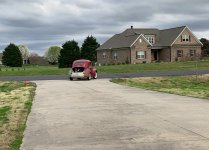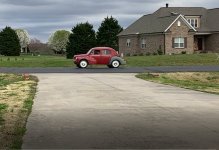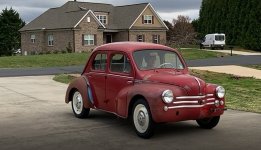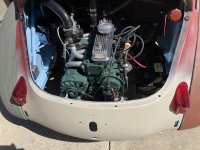Oh wow. Wow! Nice work Stan 

You are using an out of date browser. It may not display this or other websites correctly.
You should upgrade or use an alternative browser.
You should upgrade or use an alternative browser.
1959 4cv Restoration in North Carolina USA
- Thread starter Stan W
- Start date
The first drive in 50 years!

 Moving along at 20mph - sounds like 100 without the headliner!
Moving along at 20mph - sounds like 100 without the headliner!

At the end of this short drive, the automatic choke was off and I adjusted the idle speed and mixture.
I have installed the alternator. I will try it out when it quits raining. The main jet access bolt was leaking at the fiber washer. I didn't have any more fiber washers, so I used a copper washer and a little fuel resistant sealant. It hasn't leaked again yet.

 Moving along at 20mph - sounds like 100 without the headliner!
Moving along at 20mph - sounds like 100 without the headliner!
At the end of this short drive, the automatic choke was off and I adjusted the idle speed and mixture.
I have installed the alternator. I will try it out when it quits raining. The main jet access bolt was leaking at the fiber washer. I didn't have any more fiber washers, so I used a copper washer and a little fuel resistant sealant. It hasn't leaked again yet.
Quite an achievement Stan.
I have driven the car about 5 miles. General driving impressions: It is LOUD inside the car. Everything that can rattle does rattle. The back seat is in place, but the jute felt behind it and below the rear window has been removed. I assume that the absence of a headliner also makes it loud. The turning radius is amazing. The transmission works perfectly and shifts well. Above 20 mph, there is a noticeable whine from the crownwheel gears. The 4cv I had back in 1975 had a similar whine to the best of my memory. I don't know if this is mostly due to worn gears or the lack of isolation between the powertrain and the body. The engine has plenty of pulling power, but the gearing is SO low. A Dauphine transmission would be better considering the added engine power.
I need suggestions for mounting seat belts for the front seats. Lap belts only, just need to get the mounts properly fastened.
I also need to build a towbar that can be easily connected and disconnected. I was thinking of something that fastened to the bumper brackets. What sort of towbars have you used or built?
I also need to build a towbar that can be easily connected and disconnected. I was thinking of something that fastened to the bumper brackets. What sort of towbars have you used or built?
You may as well go lap sash - remember that with the passive safety features of a 4CV if you hit anything substantial, or it hits you, they will just open the door and hose you out into a body bag.
It is possible to drill and reinforce the door pillar and easy enough to put plates under the floor for the belt mounts.
May as well maximise your chabces of enjoying it for as long as possible. You have done a meticulous job so far.
Best Wishes
Andrew
It is possible to drill and reinforce the door pillar and easy enough to put plates under the floor for the belt mounts.
May as well maximise your chabces of enjoying it for as long as possible. You have done a meticulous job so far.
Best Wishes
Andrew
I've had lap-sash belts for 50 years. Recently I went to a professional seat belt engineering company and had them upgrade and certify the mounts and replace the webbing. This means that inadequate belts or mounts can't negate my insurance!!!!!!!!!!!!!! You could lose your house if the seat belts don't comply with current engineering standards.
You can get excessive noise if by chance the muffler just touches the bodywork. There are plenty of places to upgrade the sound insulation, and some cars had stuff glued onto the roof above the lining. Quite a long topic, that one. We've been spoiled by modern cars' noise levels of course!
So good that it is going!!
You can get excessive noise if by chance the muffler just touches the bodywork. There are plenty of places to upgrade the sound insulation, and some cars had stuff glued onto the roof above the lining. Quite a long topic, that one. We've been spoiled by modern cars' noise levels of course!
So good that it is going!!
I understand the danger of driving the 4cv and so does my wife. The belts will be for the small amount of driving on roads at speeds of around 25 mph or less. A lap belt can be very helpful if you bump into something at low speeds. We don't have the liability issue with seat belts on antique cars here. I will probably weld in a reinforcement plate and weld the mount to that.
Are the bumper brackets strong enough to tow the car?
Are the bumper brackets strong enough to tow the car?
I installed the alternator and it works properly. The alternator has three terminals - output, dash light and voltage sense. The dash light works the same as when hooked up to a generator. Some people hook up the voltage sense wire to the output, but that isn't recommended. I ran a short wire from the ignition coil feed to the alternator sense terminal. That gives a good signal as far from the alternator output as possible. I have a small oil leak from the front of the engine. It leaked a lot more when I first started it up. Is this normal and will it go away as the engine is broken in?
As for tow bars, I see that there are plenty of adjustable ones that will work fine.

As for tow bars, I see that there are plenty of adjustable ones that will work fine.

The voltage sense wire is usually hooked up to the battery, seeing as the battery is in the front that makes a long wire. A better place for it is probably the main terminal on the starter motor solenoid as there will be less voltage drop because of the larger size of wire. You will also need a relay so not to flatten the battery when the car is not in use.I installed the alternator and it works properly. The alternator has three terminals - output, dash light and voltage sense. The dash light works the same as when hooked up to a generator. Some people hook up the voltage sense wire to the output, but that isn't recommended. I ran a short wire from the ignition coil feed to the alternator sense terminal. That gives a good signal as far from the alternator output as possible. I have a small oil leak from the front of the engine. It leaked a lot more when I first started it up. Is this normal and will it go away as the engine is broken in?
As for tow bars, I see that there are plenty of adjustable ones that will work fine.
View attachment 131566
Voltage sense should be connected to battery positive terminal.The voltage sense wire is usually hooked up to the battery, seeing as the battery is in the front that makes a long wire. A better place for it is probably the main terminal on the starter motor solenoid as there will be less voltage drop because of the larger size of wire. You will also need a relay so not to flatten the battery when the car is not in use.
The purpose is to allow compensation for voltage drop in the alternator "charging "cable.
Towbar on my car
This picture is taken from underneath showing the plate I attach the towbar to. This plate is barely visible when the the towbar is not attached. The plate in welded onto a 2" rectangular hollow section (painted black) and this bar is bent to the shape of the bumper bar and a plate attached each end through the body with the bumper bar brackets and bolted to the chassis together with the bumper bar brackets.
I hope this helps, let me know if you have any questions.
Frank
Thanks for the pictures. I might be using the wrong term, I am wanting something to hook up to my regular car to tow the 4cv - similar to what people use to tow vehicles behind motor homes (not sure if that term is used in AU).
My 4cv now has about eight or nine miles and has had about five heat up and cool down cycles. I was thinking of changing the oil and torquing down the head bolts. Is this too soon, or is it a good time? I used conventional 30 weight oil to start with. I am consider using a conventional multi weight oil, either 20w-50 or 10w-40. What do you use?
My 4cv now has about eight or nine miles and has had about five heat up and cool down cycles. I was thinking of changing the oil and torquing down the head bolts. Is this too soon, or is it a good time? I used conventional 30 weight oil to start with. I am consider using a conventional multi weight oil, either 20w-50 or 10w-40. What do you use?
So good to read these posts.
Regarding the oil leak, what do you mean by the "front" of the engine. Mine's never been perfectly dry at the timing gear end and it does need a new crankshaft seal. But the sump corners are hard to get quite right and I always have suspected the paper seal behind the timing gears.
I think that the bumper brackets are fine for towing but don't actually KNOW.
For oil I used to use 20-40 (Castrol XL) but the currently available one from our Penrite company has changed from 20-50 to 20-60 - it is a mineral oil with "full zinc". I don't know but there is a school of thought that modern oils without the zinc-phosphate-organic additive risk cam and lifter damage.
With a bit more power, as you have, the gearing will be a bit low. Still, more acceleration though!
Great it is going. A whole lot of sound damping will help a lot, as will getting used to the noise of a 1950s car again....
Cheers
Regarding the oil leak, what do you mean by the "front" of the engine. Mine's never been perfectly dry at the timing gear end and it does need a new crankshaft seal. But the sump corners are hard to get quite right and I always have suspected the paper seal behind the timing gears.
I think that the bumper brackets are fine for towing but don't actually KNOW.
For oil I used to use 20-40 (Castrol XL) but the currently available one from our Penrite company has changed from 20-50 to 20-60 - it is a mineral oil with "full zinc". I don't know but there is a school of thought that modern oils without the zinc-phosphate-organic additive risk cam and lifter damage.
With a bit more power, as you have, the gearing will be a bit low. Still, more acceleration though!
Great it is going. A whole lot of sound damping will help a lot, as will getting used to the noise of a 1950s car again....
Cheers
I don't know these cars but would suggest that if you used the bumper attachments for towing you would need to inspect where the force is applied to the chassis. Some cars (like the R12 or R10) have some thingos behind the bumpers, which are designed to deform on impact (under compression) but would not take kindly to being pulled (i.e. they would probably pull off the car). At least if you use a triangle thingo with the three vertices being tow hook and bumper attachments I would suggest you need a spacer along the bumper attachment side so you don't end up pulling them together.
How do you intend to steer the towed car? I would have a look at existing things like that (I know I've seen them).
How do you intend to steer the towed car? I would have a look at existing things like that (I know I've seen them).
I don't know if it is too soon or not but I would recommend re-torqueing the manifold nuts at the same time because the manifold gasket can compress and loosen the nuts which might not be apparent to a visual or finger-tight inspection. The nuts can become loose when things get hot resulting in mystery ailments... don't ask me how I know this.I was thinking of changing the oil and torquing down the head bolts. Is this too soon, or is it a good time?
Thank you for the thoughts on the tow bar. The bumper brackets are attached to the most solid part of the front of the car. They should be just fine under tension. I had not thought about a brace to keep the brackets from being pulled together. It is a good idea and I could easily make one. Many years ago, I restored a 1961 VW bug. I bought a tow bar to flat tow the VW. The steering was not a problem. I think that it is a matter of not expecting to make tight turns. There might be just a little scuffing of the front tires when turning.
I will re-torque the manifold nuts - thanks for suggesting it.
I will re-torque the manifold nuts - thanks for suggesting it.
I installed austin mini rear shocks on the front of the 4cv. There are speed bumps on our neighborhood street which give a good test for the shock absorbers. The shocks are just right - not too stiff, not too soft.
The engine leaks a little on the flywheel end, I don't think it is the gasket. The timing cover end is fine. I will get underneath the car soon and inspect it carefully.
The engine leaks a little on the flywheel end, I don't think it is the gasket. The timing cover end is fine. I will get underneath the car soon and inspect it carefully.
Does this help? Post #736 shows how Frans tows his R8.
https://www.aussiefrogs.com/forum/index.php?threads/two-new-racecars-in-nz.23664/page-37
https://www.aussiefrogs.com/forum/index.php?threads/two-new-racecars-in-nz.23664/page-37